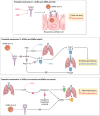Renin-angiotensin system blockade in the COVID-19 pandemic
- PMID: 33796285
- PMCID: PMC7929063
- DOI: 10.1093/ckj/sfab026
Renin-angiotensin system blockade in the COVID-19 pandemic
Abstract
In the early months of the coronavirus disease 2019 (COVID-19) pandemic, a hypothesis emerged suggesting that pharmacologic inhibitors of the renin-angiotensin system (RAS) may increase COVID-19 severity. This hypothesis was based on the role of angiotensin-converting enzyme 2 (ACE2), a counterregulatory component of the RAS, as the binding site for severe acute respiratory syndrome coronavirus 2 (SARS-CoV-2), allowing viral entry into host cells. Extrapolations from prior evidence led to speculation that upregulation of ACE2 by RAS blockade may increase the risk of adverse outcomes from COVID-19. However, counterarguments pointed to evidence of potential protective effects of ACE2 and RAS blockade with regard to acute lung injury, as well as substantial risks from discontinuing these commonly used and important medications. Here we provide an overview of classic RAS physiology and the crucial role of ACE2 in systemic pathways affected by COVID-19. Additionally, we critically review the physiologic and epidemiologic evidence surrounding the interactions between RAS blockade and COVID-19. We review recently published trial evidence and propose important future directions to improve upon our understanding of these relationships.
Keywords: COVID-19; SARS-CoV-2; angiotensin II receptor blocker; angiotensin-converting enzyme 2; angiotensin-converting enzyme inhibitor; coronavirus; hypertension; renin–angiotensin system.
© The Author(s) 2021. Published by Oxford University Press on behalf of ERA-EDTA.
Figures

References
-
- Kane SP. ClinCalc DrugStats Database, Version 21.0. https://clincalc.com/DrugStats/Top300Drugs.aspx (29 November 2020, date last accessed)
-
- Sparks MA, Hiremath S, South A. et al. The Coronavirus Conundrum: ACE2 and Hypertension Edition. http://www.nephjc.com/news/covidace2 (2 November 2020, date last accessed)
Publication types
Grants and funding
LinkOut - more resources
Full Text Sources
Other Literature Sources
Miscellaneous

